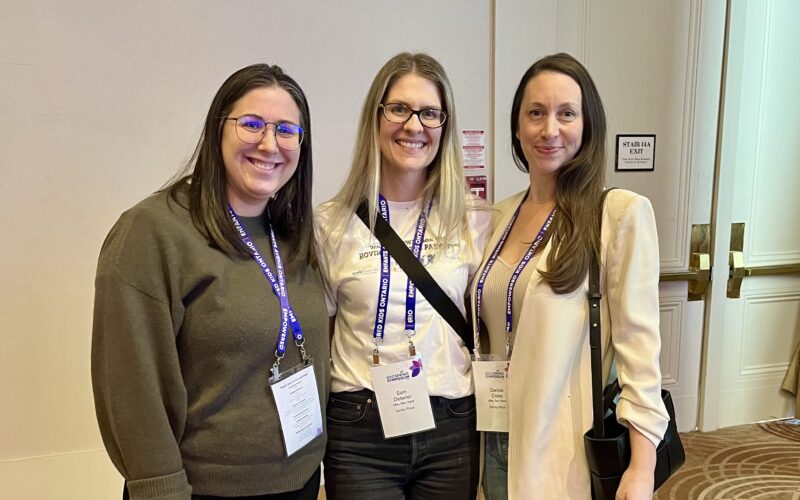It’s Ethics Week at Surrey Place, a time to raise awareness about health ethics and reflect on ethical issues facing people with intellectual and developmental disabilities (IDD). Ethical behaviours are a crucial element of healthcare and are fundamental to providing high-quality patient services. Unfortunately, people with intellectual disabilities and autism continue to experience various forms of oppression and unjust treatment that significantly impacts their access to care and services.
At Surrey Place, championing our clients’ health, wellbeing and ethical treatment is embedded in everything we do. To help raise awareness of this issue, we caught up with Surrey Place’s Andria Bianchi, PhD, Bioethicist and Janet A. Vogt, PhD, MHSc Bioethics, Senior Research Associate and Manager, to learn more about their latest book, Intellectual Disabilities and Autism: Ethics and Practice, which meaningfully reflects upon difficult, timely, and debated ethics questions relating to people with IDD and autistic people.
Congratulations on this big accomplishment. To start, can you talk briefly about your book and what inspired you to write it?
Janet & Andria: The book came from our shared experience in academic bioethics, where we both felt the population we serve was not well represented. We often didn’t find discussion of ethical challenges in providing care to people with intellectual disabilities and autism. We felt that this was an immense gap that needed to be addressed meaningfully.
What would you say are the biggest misconceptions of people with intellectual and developmental disabilities?
Janet & Andria: I think it’s the assumptions regarding their abilities that are much more focused on what they cannot do. As those working in our sector and the book’s authors know, this assumption is entirely inaccurate and unfair. People with IDD have countless capabilities, and there exists a moral obligation to ensure these abilities can be realized.
In your opinion, what are the effects of the barriers that people with intellectual and developmental disabilities are facing?
Janet & Andria: Like any barrier, they prevent development and progress for the person. In this case, barriers to access, whether it be to appropriate healthcare services, educational opportunities, employment, housing, community participation; flourishing of capabilities, which is intertwined with access or lack thereof; a lack of meaningful social inclusion and, perhaps worst of all, stigma.
From a developmental sector perspective, are there initiatives and work underway to alleviate these obstacles?
Janet & Andria: Of course. The book features some of these initiatives and looks at the ethical arguments underpinning much of our work in this sector. For example, many chapters feature aspects of social inclusion and empowerment. These include chapters on advocacy (including self-advocacy), employment, engagement with politics, digitally inclusive support practices, and sexual and reproductive autonomy.
The book features several notable practitioners and academics interested in intellectual and developmental disabilities and autism. What did you look for in each of these advocates, and how did you identify them?
Janet & Andria: We had two types of authors in mind. One type was the academic whose works we were aware of and whom we considered to be pushing the boundaries of discourse around intellectual disabilities and autism. This included Jonas Stephan Beaudry, Abraham Graber, Stacy Simplican, Chris Kaposy, Lorraine McCrary, Trudo Lemmens, Tim Stainton, and others who fall into this category.
On the other hand, we wanted to combine their thought-provoking argumentative chapters with some of the work being done to address issues of access, empowerment, and flourishing. This brings us to the second author type – the practitioner or researcher. We also wanted to include early-career, mid-career, and experienced researchers, practitioners, and authors with lived experiences in the volume. Thankfully, authors in each category contributed to the wonderful chapters that make up the volume.
Did you uncover anything surprising through the book development process?
Janet & Andria: We allowed authors some latitude in their writing, as we thought it would be important for them to find their respective topics engaging. One thing that surprised us was how little changes to the direction of a chapter could present significant challenges to the book’s structure.
The book currently has seven sections: (1) moral status, (2) capacity and consent; (3) inclusion and empowerment: society, systems, and ethics; (4) inclusion and empowerment: practical approaches; (5) sexuality, intimacy, romance and parenting; (6) health care; and (7) ethical responses to ‘behaviours.’ These sections and what’s contained within them constantly changed based on what was submitted to us. It was a wonderfully worthwhile process filled with surprises along the way!
What was the most rewarding moment you experienced during the writing process?
Janet & Andria: Every time we received a manuscript and had the privilege of reading the work for the first time and engaging in a dialogue with the author, it was a rewarding experience. We never tired of this.
What do you hope readers will take away from your book?
Janet & Andria: For our colleagues at Surrey Place, we hope they will see themselves and their co-workers represented within this volume. Obviously, we could not capture all the wonderful things Surrey Place and others in the developmental sector are doing, but this volume is a starting point. We hope they find all the chapters interesting, challenging and can learn from them.
We hope that bioethicists and their trainees will recognize that work in our sector presents many ethical challenges, and clinicians, leaders, and families regularly engage with these challenges. Perhaps we can start raising awareness within the bioethics community that can, in turn, influence the healthcare environment in which many bioethicists work.
Finally, we are optimistic that college and university students in healthcare disciplines, social sciences, disability studies, etc., may find these chapters challenging and rewarding.
Do you have any advice for people on how to better support the IDD community?
Janet & Andria: You have to see the person…not the disability. Stigma can be a lifelong challenge for our clients. We need to get better at educating people about the hidden biases we all harbour and challenging people to rise above their own biases. We also need to get better at promoting the capabilities of all people with IDD and autism, especially in the sense of helping others see the person’s abilities.
How can people find out more or purchase the book?
Janet & Andria: The book is now available online through our publisher, Springer Nature,
Intellectual Disabilities and Autism: Ethics and Practice | SpringerLink.
Congratulations to Andria and Janet on all their hard work!
Enjoy 20% off your book purchase with this QR and code I9rXJXJXbr7UGE

Code: I9rXJXJXbr7UGE


